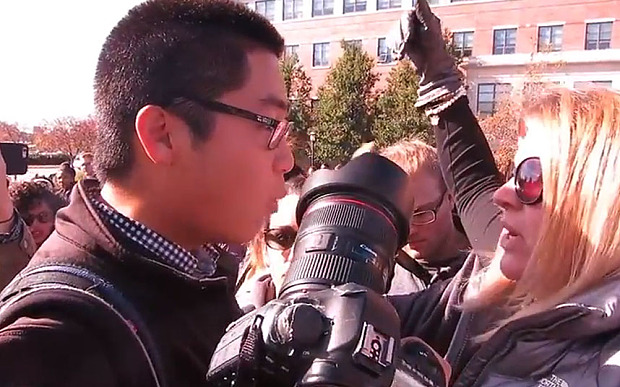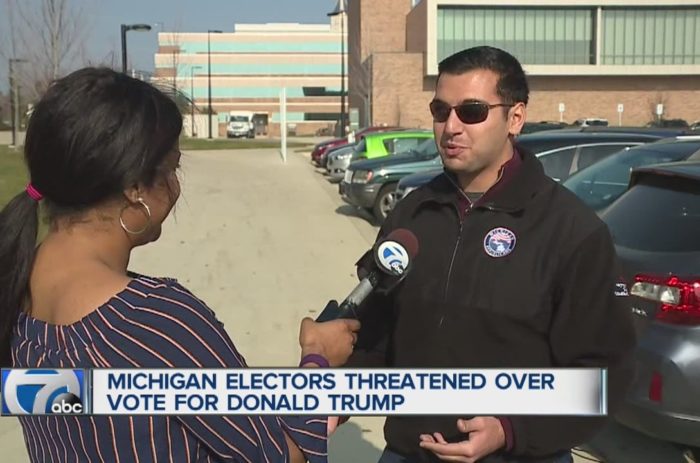
The University of Missouri's journalism school praised a student journalist Tuesday after he stood his ground and asserted his First Amendment right to take pictures of a campus protest, despite aggressive pushback from a mob of students and faculty members. The student journalist, Tim Tai (left), believed to be on assignment by ESPN, is confronted and told to leave the area. (Mark Schierbecker)
The following is an excerpt from OpinionJournal’s “Best of the Web” at WSJ written by the editor, James Taranto.
Reader Tim McAleenan, a third-year law student at the University of Missouri, forwards an announcement he received by email this morning from the campus police, with the subject line “Reporting Hateful and/or Hurtful Speech”:
To continue to ensure that the University of Missouri campus remains safe, the MU Police Department (MUPD) is asking individuals who witness incidents of hateful and/or hurtful speech or actions to:
• Call the police immediately at [phone number redacted]. (If you are in an emergency situation, dial 911.)
• Give the communications operator a summary of the incident, including location.
• Provide a detailed description of the individual(s) involved.
• Provide a license plate and vehicle descriptions (if appropriate).
• If possible and if it can be done safely, take a photo of the individual(s) with your cell phone.
Delays, including posting information to social media, can often reduce the chances of identifying the responsible parties. While cases of hateful and hurtful speech are not crimes, if the individual(s) identified are students, MU’s Office of Student Conduct can take disciplinary action.
We spoke with Maj. Brian Weimer, the campus police’s public information officer, who confirms the email is genuine. It’s also very troubling.
The context: As The Wall Street Journal reports, Tim Wolfe resigned yesterday as president of the University of Missouri “after weeks of mounting student protests over what they called poor handling of several recent racial incidents”:
The incidents included a swastika scribbled with feces in a dorm, racial epithets directed at black students and what some said was President Tim Wolfe’s muted response to last year’s violence in Ferguson, Mo., 110 miles away from the main Columbia, Mo., campus, home to 35,000 students.
A growing campus movement protesting the administration mushroomed in recent weeks, with one graduate student, Jonathan Butler, staging a seven-day hunger strike in an effort to pressure Mr. Wolfe to resign. A turning point came over the weekend when members of the football team said they would boycott this weekend’s game against Brigham Young University unless Mr. Wolfe resigned or was fired—a declaration endorsed by head coach Gary Pinkel. A forfeit could have cost the school $1 million, officials said.
The protests included a bizarre scene on campus, described by the New York Times:
A video that showed University of Missouri protesters restricting a student photographer’s access to a public area of campus on Monday ignited discussions about press freedom.
Tim Tai, a student photographer on freelance assignment for ESPN, was trying to take photos of a small tent city that protesters had created on a campus quad. Concerned Student 1950, an activist group that formed to push for increased awareness and action around racial issues on campus, did not want reporters near the encampment.
Protesters blocked Mr. Tai’s view and argued with him, eventually pushing him away. At one point, they chanted, “Hey hey, ho ho, reporters have got to go.”
“I am documenting this for a national news organization,” Mr. Tai told the protesters, adding that “the First Amendment protects your right to be here and mine.” . . .
As the video nears its end, the person taking the video, Mark Schierbecker, emerged from the scrum and approached a woman, later identified as an assistant professor of mass media, Melissa Click, close to the tents. When he revealed that he was a journalist, Ms. Click appeared to grab at his camera.
She then yelled, “Who wants to help me get this reporter out of here? I need some muscle over here.”
Click, it should be noted, is a professor in the School of Communication, which is separate from the well-regarded Missouri School of Journalism—though the J-school also lists her as an adjunct faculty member. “Journalism School faculty members are taking immediate action to review that appointment,” the dean, David Kurpius, says in a statement.
According to her online bio, her “current research projects involve 50 Shades of Grey readers, the impact of social media in fans’ relationship with Lady Gaga, masculinity and male fans, messages about class and food in reality television programming, and messages about work in children’s television programs.” She earned her doctorate at the University of Massachusetts, Amherst, with a dissertation titled “It’s ‘a Good Thing’: The Commodification of Femininity, Affluence, and Whiteness in the Martha Stewart Phenomenon.”
Tai clearly was in the right; as the student newspaper, the Maneater, reported in September, public universities in Missouri are subject to an unusually permissive free-speech regime:
On July 14, Gov. Jay Nixon signed Senate Bill 93, also known as the “Campus Free Expression Act.” The bill expands free speech zones on the campuses of public institutions of higher education in Missouri, such as MU’s Speakers Circle, and allows protests and speeches to take place on any outdoor space.
By eliminating free speech zones, expressive acts, such as protests and speeches, can be held throughout campuses, making college campuses “traditional public forums,” according to the bill. The bill was passed unanimously in the state Senate, making Missouri the second state along with Virginia to have passed legislation of this kind to protect the First Amendment rights of students on college campuses.
Members of the media are every bit as entitled to the protections of a public forum as protesters are. Writing for the New York-based Columbia Journalism Review, Jonathan Peters declares his sympathy for “the student protesters:
I mean, yes, it puzzles me why it would seem principled to the student activists to overtake a public forum for their own expressive activities and then to declare the forum a safe space, with the intent or effect of making it unavailable for others to engage in expressive activities there. That’s inconsonant with the values that underlie the First Amendment—and the theory that public forums, like the quad, have been “held in trust for the use of the public and, time out of mind, have been used for purposes of assembly, communicating thoughts between citizens, and discussing public questions,” according to the US Supreme Court. . . .
But the students feel passionately—with good reason—and I wouldn’t expect them to know where all of the constitutional speed bumps are located in the quad. I’ll simply implore them to consider the First Amendment’s nonexclusivity along with the righteousness of their cause.
The adults, however, are another story.
Which brings us back to that campus police email. What in the world is a law-enforcement agency doing soliciting reports about speech that the cops themselves concede is not criminal?
“We’re just the reporting agency,” Maj. Weimer told this columnist. The police aren’t going to arrest anybody, or even write tickets, for “hateful” or “hurtful” speech. As the email said, they mean only to pass the reports on to the university, which can take action under its Code of Student Conduct.
Certain categories of speech—“fighting words” and incitement—are in fact unprotected by the First Amendment and may be subject to criminal penalties. (The vandalism of a public rest room would be a crime independent of any expressive content.) No doubt there is some overlap between those categories and “hateful” and “hurtful” speech. But the campus police email specifically urges the reporting of “cases of . . . speech” that “are not crimes.” The University of Missouri, a public institution, seeks to punish protected speech, and it is using the instruments of law enforcement to do so.
And the literal policing of speech at Missouri cuts both ways in the current conflict. It’s a truism of free expression that, to paraphrase Justice Louis Brandeis, the remedy for objectionable speech is more speech. By discouraging the “posting [of] information to social media,” the Missouri campus police attempt, albeit through exhortation rather than force, to shut that down too.
For more “Best of the Web” click here and look for the “Best of the Web Today” link in the middle column below “Today’s Columnists.”



